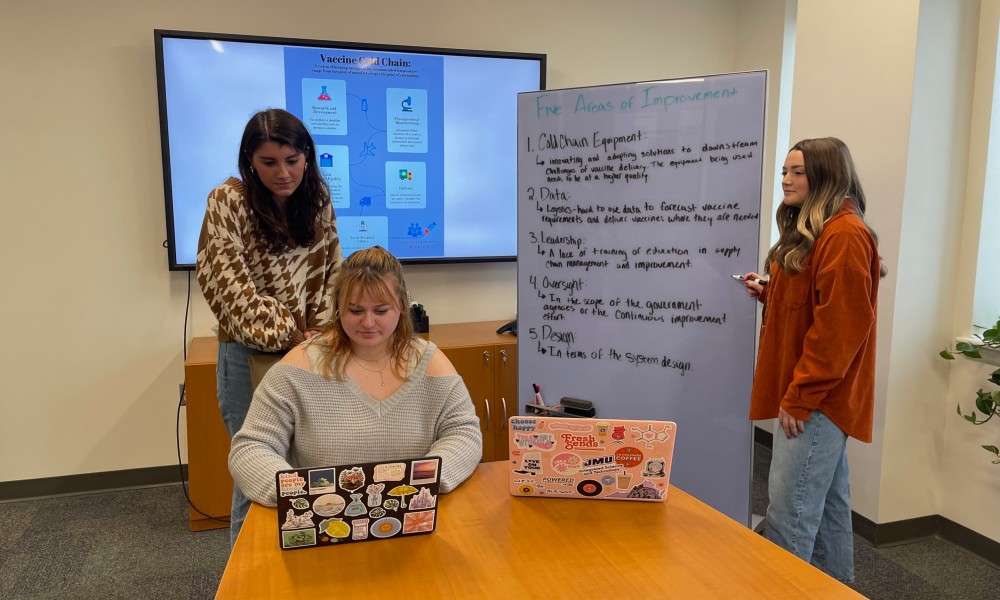ISAT students investigate challenges in the vaccine supply chain
News
In response to the supply chain challenges facing the COVID-19 vaccine, three Integrated Science and Technology (ISAT) students - Ava Carr, Abby Robinson, and Meghan Gelerman - collaborated on a capstone project that united their interests in biotechnology and supply chain management. Their project tackled one of the most critical global issues of our time: the distribution of the COVID-19 vaccine.
Carr, Robinson, and Gelerman consulted with two ISAT professors, Rebecca Simmons and Amanda Sanson, to gain a well-rounded perspective on vaccine distribution. Simmons is renowned for her expertise in global supply chain management, while Sanson is a well-regarded expert in biotechnology.
Together, the team explored the science behind the vaccine and technologies to improve the distribution process. They identified and evaluated existing problems within vaccine development and distribution throughout history, why they happened, and which ones still impact the vaccine supply chains today. Finally, they aim to propose solutions to implement and improve vaccine supply chain management. “We think it would be really cool if we could have potential solutions that experts in the field could implement,” Carr said.
“This is one of my favorite capstones,” Sanson said. “It integrates so many of the things we teach ISAT students — taking multiple sectors and integrating them into a solution for a global problem.”
The project has investigated vaccine distribution issues in five key areas: leadership, oversight, cold chain equipment, design, and data. However, through research, the team narrowed it down to three main areas that leaders should focus on to improve the vaccine supply chain – leadership, oversight, and cold chain equipment.
“What surprised me the most was the importance of cold chain equipment—refrigeration that allows vaccines to be stored at appropriate temperatures,” explains Robinson. “The lack of access to cold chain equipment in remote areas is often a reason why the distribution of vaccines isn’t always equal across the country,” she adds. “It can also be challenging to ensure consistency in cold chain equipment.
“One of the challenges is that it has to be ridiculously cold,” Simmons said. “But another problem is monitoring the temperature throughout to ensure [vaccines] stay cold the entire time they’re being transported.”
Simmons was surprised at how differently each state handled vaccine distribution. “Alaska has a remarkably successful vaccine distribution process,” says Simmons.
“Alaska is a secluded state that has learned to be prepared and self-sufficient,” says Robinson.
“It’s almost like [Alaska] ran its own little country when it came to the vaccine distribution,” she adds.
The team also evaluated West Virginia and Maryland. Their research revealed that although Maryland has a better healthcare system overall, the state did poorly in vaccine distribution. West Virginia was successful despite needing to strengthen its healthcare system.
“West Virginia stood out,” Carr said. “They did this by having good leadership and oversight in handling the distribution and allocation of vaccines.”
West Virginia partnered with small local pharmacies instead of big companies like CVS or Walgreens. Community members were more trusting of smaller businesses. The state also organized its vaccine information online and in one place. Conversely, Maryland separated vaccine distribution by county – making it difficult to find information.
“I was surprised that [the team’s] work seemed to show that the quality of overall healthcare in a state did not align with the efficacy with which the state was distributing vaccines,” Sanson said.
Sourcing information on which states had more failures was more challenging than the success stories,” says Carr. “It’s hard to find information on why things didn’t work out because most government officials in those states don’t want the public to know how badly they handled it.”
“Completing a project like this is a struggle because new research and information about the COVID-19 vaccine distribution is being released all the time,” notes Simmons.
“When you’re working on studying something while it’s happening, there’s always new information, there’s always changes, and so just keeping up with that has been tricky,” she adds.
“Their project is a testament to the potential for interdisciplinary collaboration to address complex global issues,” says Bob Kolvoord, Dean of JMU’s College of Integrated Science and Engineering. “Their work highlights the importance of bringing together different perspectives and skill sets to tackle challenges in biotechnology and supply chain management.”
“Looking at the successes and failures of the COVID-19 vaccine distribution is vital to improving future vaccination efforts,” says Simmons.
“I think our project brought possible solutions to light,” says Carr. “There will always be issues with vaccine supply chains, but the three areas we focused on will help leaders and companies prevent or minimize the damage to their supply chains.”
Learn more about JMU's Integrated Science and Technology major
